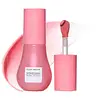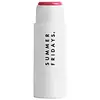Glow Recipe Watermelon Glow Niacinamide Dewy Flush Versus Summer Fridays Blush Balm Stick Cheek + Lip Stick
What's inside
What's inside
 Key Ingredients
Key Ingredients

 Benefits
Benefits

 Concerns
Concerns

 Ingredients Side-by-side
Ingredients Side-by-side

Water
Skin ConditioningDicaprylyl Ether
EmollientSqualane
EmollientIsoamyl Laurate
EmollientOctyldodecanol
EmollientC10-18 Triglycerides
EmollientAluminum Starch Octenylsuccinate
AbsorbentCaprylic/Capric Triglyceride
MaskingNiacinamide
SmoothingJojoba Esters
EmollientPolyglyceryl-6 Polyhydroxystearate
EmulsifyingPolyglyceryl-6 Polyricinoleate
EmulsifyingGlyceryl Behenate
EmollientHelianthus Annuus Seed Wax
Skin ConditioningHydrogenated Poly(C6-20 Olefin)
AbrasiveMagnesium Sulfate
Citrullus Lanatus Fruit Extract
Skin ConditioningCentella Asiatica Extract
CleansingHyaluronic Acid
HumectantLeuconostoc/Radish Root Ferment Filtrate
AntimicrobialAcacia Decurrens Flower Extract
MaskingGlycerin
HumectantCoco-Caprylate/Caprate
EmollientDisteardimonium Hectorite
StabilisingDilinoleic Acid/Butanediol Copolymer
Polyglycerin-6
HumectantMica
Cosmetic ColorantPropylene Carbonate
SolventTriheptanoin
Skin ConditioningHdi/Trimethylol Hexyllactone Crosspolymer
Dodecane
PerfumingPolyglycerin-3
HumectantEthylhexylglycerin
Skin ConditioningSorbitan Oleate
EmulsifyingPhenoxyethanol
PreservativeCastor Oil/Ipdi Copolymer
Trihydroxystearin
Skin ConditioningTocopherol
AntioxidantParfum
MaskingCI 77891
Cosmetic ColorantCI 15850
Cosmetic ColorantCI 77491
Cosmetic ColorantCI 77499
Cosmetic ColorantCI 45410
Cosmetic ColorantCI 15985
Cosmetic ColorantCI 42090
Cosmetic ColorantWater, Dicaprylyl Ether, Squalane, Isoamyl Laurate, Octyldodecanol, C10-18 Triglycerides, Aluminum Starch Octenylsuccinate, Caprylic/Capric Triglyceride, Niacinamide, Jojoba Esters, Polyglyceryl-6 Polyhydroxystearate, Polyglyceryl-6 Polyricinoleate, Glyceryl Behenate, Helianthus Annuus Seed Wax, Hydrogenated Poly(C6-20 Olefin), Magnesium Sulfate, Citrullus Lanatus Fruit Extract, Centella Asiatica Extract, Hyaluronic Acid, Leuconostoc/Radish Root Ferment Filtrate, Acacia Decurrens Flower Extract, Glycerin, Coco-Caprylate/Caprate, Disteardimonium Hectorite, Dilinoleic Acid/Butanediol Copolymer, Polyglycerin-6, Mica, Propylene Carbonate, Triheptanoin, Hdi/Trimethylol Hexyllactone Crosspolymer, Dodecane, Polyglycerin-3, Ethylhexylglycerin, Sorbitan Oleate, Phenoxyethanol, Castor Oil/Ipdi Copolymer, Trihydroxystearin, Tocopherol, Parfum, CI 77891, CI 15850, CI 77491, CI 77499, CI 45410, CI 15985, CI 42090
Isododecane
EmollientGlycerin
HumectantHydrogenated Polyisobutene
EmollientSorbitan Sesquioleate
EmulsifyingC9-12 Alkane
SolventBehenyl Behenate
EmollientPolyethylene
AbrasiveBis-Diglyceryl Polyacyladipate-2
EmollientIsohexadecane
EmollientPolyhydroxystearic Acid
EmulsifyingTriethylhexanoin
MaskingDisteardimonium Hectorite
StabilisingSodium Hyaluronate
HumectantEvodia Rutaecarpa Fruit Extract
Skin ConditioningTocopheryl Acetate
AntioxidantPropanediol
SolventC13-15 Alkane
SolventCoco-Caprylate/Caprate
EmollientEthylhexyl Palmitate
EmollientSilica
AbrasiveSilica Dimethyl Silylate
EmollientAlumina
AbrasiveMagnesium Oxide
AbsorbentButylene Glycol
HumectantCaprylyl Glycol
EmollientHexylene Glycol
EmulsifyingGlyceryl Linoleate
EmollientCopernicia Cerifera Wax
Euphorbia Cerifera Wax
Trihydroxystearin
Skin ConditioningIsopropyl Titanium Triisostearate
EmollientTriethoxysilylethyl Polydimethylsiloxyethyl Dimethicone
Skin ConditioningEthylene/Propylene/Styrene Copolymer
Butylene/Ethylene/Styrene Copolymer
Pentaerythrityl Tetra-Di-T-Butyl Hydroxyhydrocinnamate
AntioxidantTriethoxycaprylylsilane
Propylene Carbonate
SolventMica
Cosmetic ColorantPhenoxyethanol
PreservativeCI 77120
Cosmetic ColorantRosin
Iron Oxides
CI 77891
Cosmetic ColorantCI 45410
Cosmetic ColorantCI 15850
Cosmetic ColorantIsododecane, Glycerin, Hydrogenated Polyisobutene, Sorbitan Sesquioleate, C9-12 Alkane, Behenyl Behenate, Polyethylene, Bis-Diglyceryl Polyacyladipate-2, Isohexadecane, Polyhydroxystearic Acid, Triethylhexanoin, Disteardimonium Hectorite, Sodium Hyaluronate, Evodia Rutaecarpa Fruit Extract, Tocopheryl Acetate, Propanediol, C13-15 Alkane, Coco-Caprylate/Caprate, Ethylhexyl Palmitate, Silica, Silica Dimethyl Silylate, Alumina, Magnesium Oxide, Butylene Glycol, Caprylyl Glycol, Hexylene Glycol, Glyceryl Linoleate, Copernicia Cerifera Wax, Euphorbia Cerifera Wax, Trihydroxystearin, Isopropyl Titanium Triisostearate, Triethoxysilylethyl Polydimethylsiloxyethyl Dimethicone, Ethylene/Propylene/Styrene Copolymer, Butylene/Ethylene/Styrene Copolymer, Pentaerythrityl Tetra-Di-T-Butyl Hydroxyhydrocinnamate, Triethoxycaprylylsilane, Propylene Carbonate, Mica, Phenoxyethanol, CI 77120, Rosin, Iron Oxides, CI 77891, CI 45410, CI 15850
 Reviews
Reviews

Ingredients Explained
These ingredients are found in both products.
Ingredients higher up in an ingredient list are typically present in a larger amount.
Ci 15850 is the pigment color red. It is an azo dye and created synthetically.
Azo dyes need to be thoroughly purified before use. This allows them to be more stable and longer-lasting.
This ingredient is common in foundations, lipsticks, and blushes. This color is described as brown/orangey red.
It has many secondary names such as Red 6 and Red 7. According to a manufacturer, Red 6 usually contains aluminum.
Learn more about CI 15850CI 45410 is a synthetic red-pigment and dye.
It often goes by both Red 28 or Red 27; manufacturers label both ingredients as CI 45410.
This dye is commonly found in makeup because it imparts a vivid color. Some types of this dye change color based on pH level and interaction with moisture:
Your skin has a natural pH of around 4.5 - 5.5.
According to the FDA, CI 45410 is not permitted for use in eye products.
Red 27 is a flourescein dye and commonly used as a fluorescent tracer in medicine.
Learn more about CI 45410Ci 77891 is a white pigment from Titanium dioxide. It is naturally found in minerals such as rutile and ilmenite.
It's main function is to add a white color to cosmetics. It can also be mixed with other colors to create different shades.
Ci 77891 is commonly found in sunscreens due to its ability to block UV rays.
Learn more about CI 77891Coco-Caprylate/Caprate is created from fatty coconut alcohol, caprylic acid, and capric acid.
It is a lightweight emollient. Emollients create a thin barrier on the skin to trap moisture in. This helps keep your skin hydrated and soft.
Once applied, Coco-Caprylate/Caprate is absorbed quickly and leaves a silky feel.
Coco-Caprylate/Caprate may not be fungal acne safe.
Learn more about Coco-Caprylate/CaprateDisteardimonium Hectorite comes from the clay mineral named hectorite. It is used to add thickness to a product.
It can also help stabilize a product by helping to disperse other ingredients.
Hectorite is a rare, white clay mineral.
Learn more about Disteardimonium HectoriteGlycerin is already naturally found in your skin. It helps moisturize and protect your skin.
A study from 2016 found glycerin to be more effective as a humectant than AHAs and hyaluronic acid.
As a humectant, it helps the skin stay hydrated by pulling moisture to your skin. The low molecular weight of glycerin allows it to pull moisture into the deeper layers of your skin.
Hydrated skin improves your skin barrier; Your skin barrier helps protect against irritants and bacteria.
Glycerin has also been found to have antimicrobial and antiviral properties. Due to these properties, glycerin is often used in wound and burn treatments.
In cosmetics, glycerin is usually derived from plants such as soybean or palm. However, it can also be sourced from animals, such as tallow or animal fat.
This ingredient is organic, colorless, odorless, and non-toxic.
Glycerin is the name for this ingredient in American English. British English uses Glycerol/Glycerine.
Learn more about GlycerinMica is a naturally occurring mineral used to add shimmer and color in cosmetics. It can also help improve the texture of a product or give it an opaque, white/silver color.
Serecite is the name for very fine but ragged grains of mica.
This ingredient is often coated with metal oxides like titanium dioxide. Trace amounts of heavy metals may be found in mica, but these metals are not harmful in our personal products.
Mica has been used since prehistoric times throughout the world. Ancient Egyptian, Indian, Greek, Roman, Aztec, and Chinese civilizations have used mica.
Learn more about MicaPhenoxyethanol is a preservative that has germicide, antimicrobial, and aromatic properties. Studies show that phenoxyethanol can prevent microbial growth. By itself, it has a scent that is similar to that of a rose.
It's often used in formulations along with Caprylyl Glycol to preserve the shelf life of products.
This ingredient is a solvent. It helps dissolve active ingredients and alter the texture of products.
Propylene Carbonate is commonly used in makeup and with clay, such as montmorillonite or bentonite.
Studies show this ingredient to be safe for cosmetics. When it is undiluted, it can cause skin irritation. (It is always diluted in skincare and makeup). This ingredient is water-soluble.
Propylene Carbonate is created from propylene glycol and carbonic acid.
Learn more about Propylene CarbonateThis ingredient comes from Hydroxystearic Acid, a fatty acid, and glycerin. It is used to thicken oils.
Due to its fatty acid content, it is a natural emollient.
Creating trihydroxystearin involves using a chemical reaction between hydrogen and castor oil.
This ingredient may not be Malassezia folliculitis safe.
Learn more about Trihydroxystearin